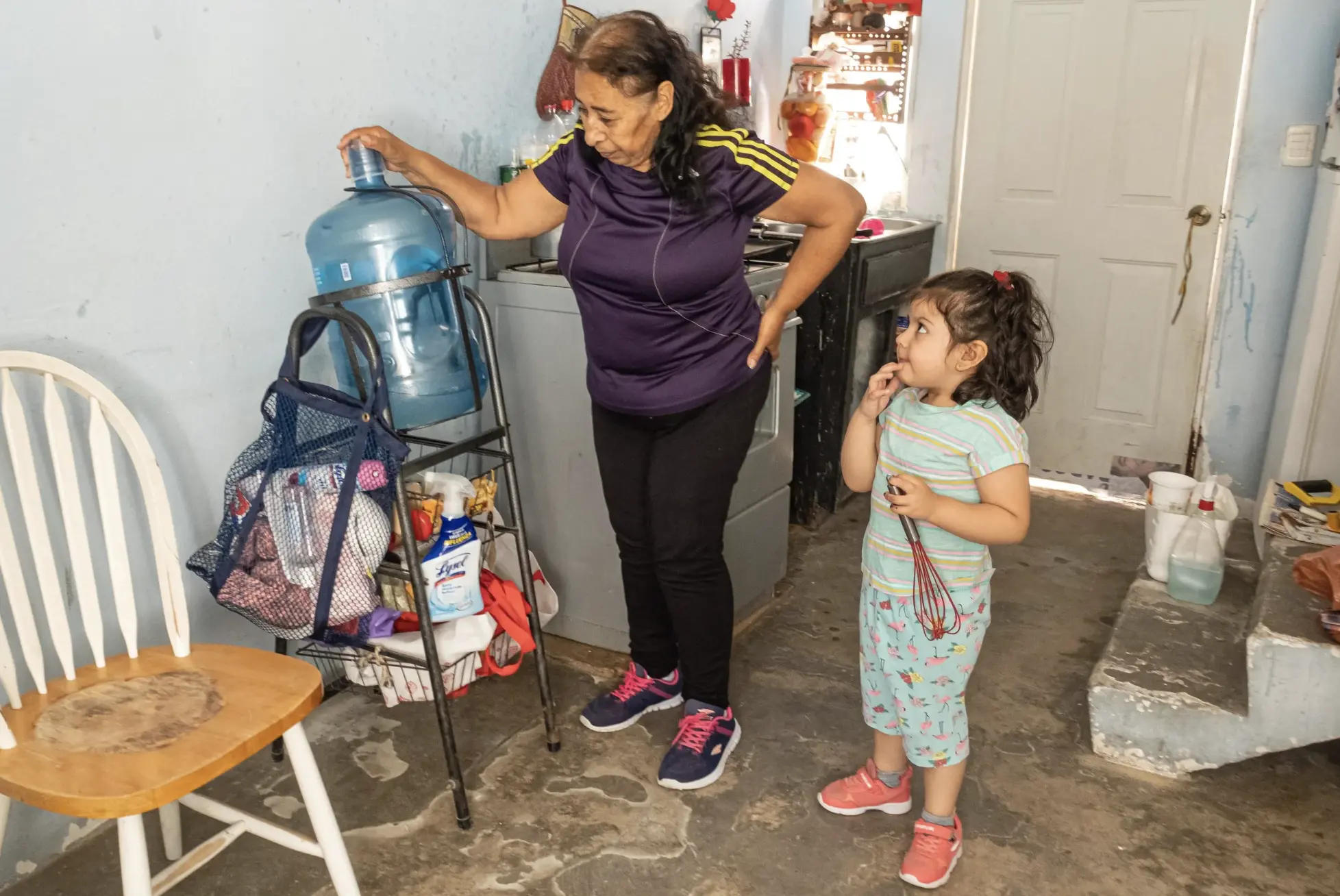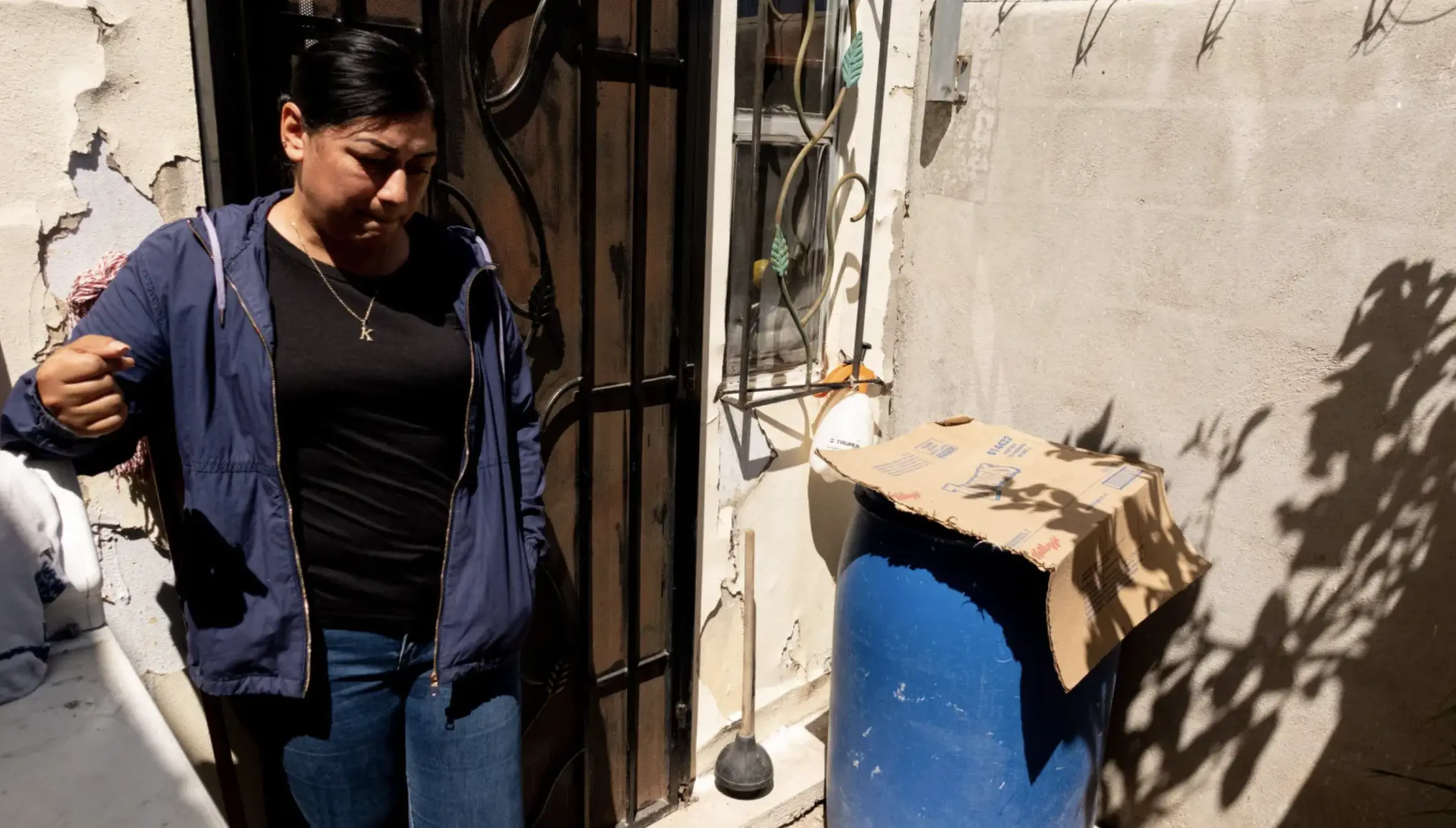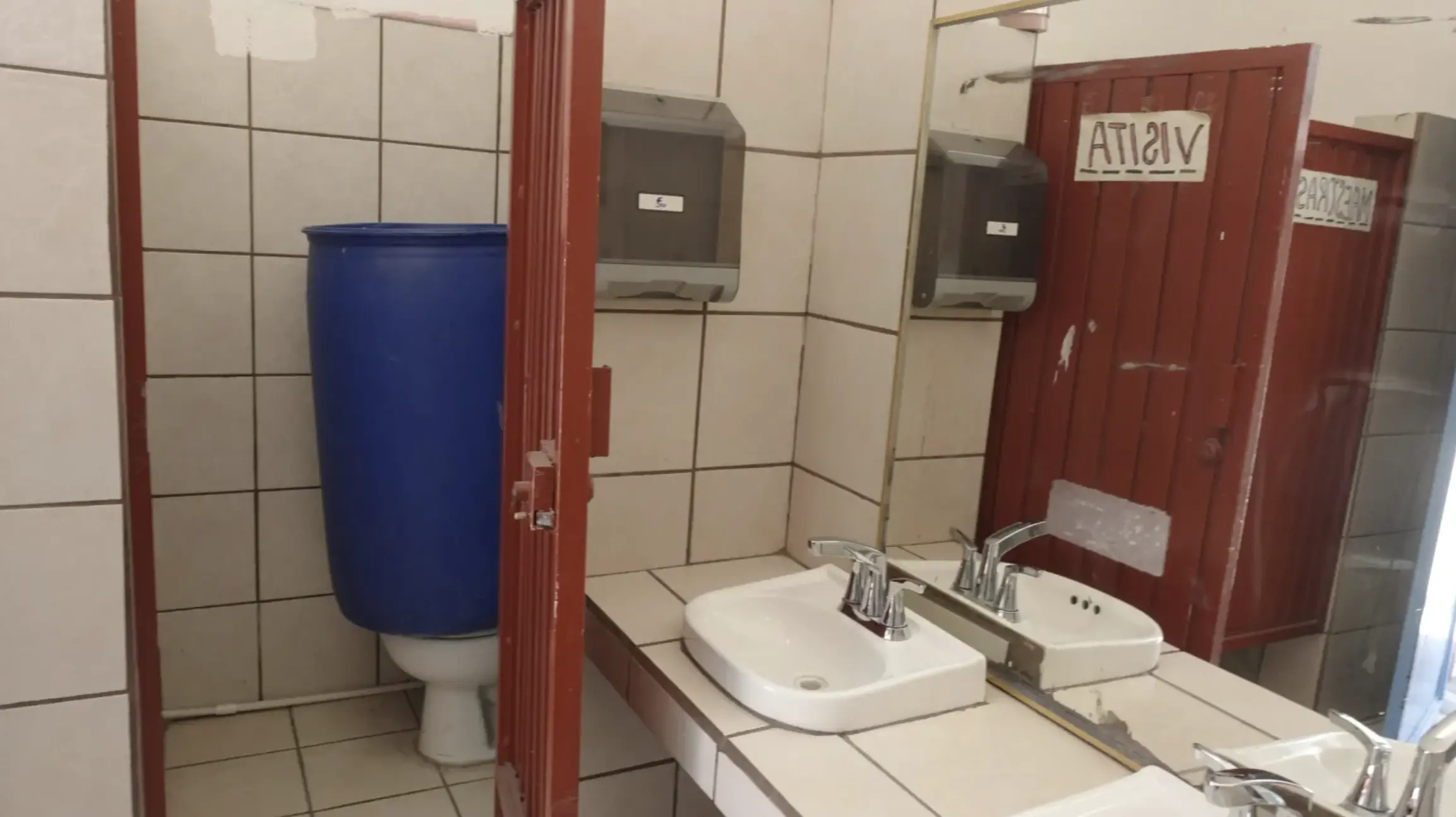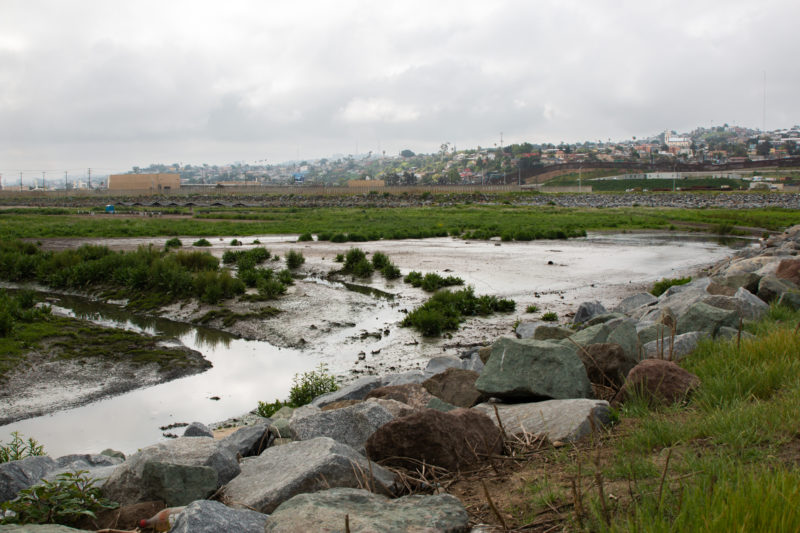
Maria Herrera had about a quarter left in her last five-gallon water jug.
On that April afternoon, though, spotty water service returned to the 67-year-old woman’s apartment, before the jug emptied. If it hadn’t, that was all she had left to bathe, do housework or drink. Herrera lives in Villas de Santa Fe, a neighborhood of cookie-cutter apartment blocks on the rapidly growing outskirts of Tijuana.
Baja’s state water agency, called CESPT, shuts off her water at least once a week, she said. Last summer, Herrera said she went six days with dry taps.

As a nonprofit journalism organization, we depend on your support to fund our nationwide Connected Coastlines climate reporting. Donate any amount today to become a Pulitzer Center Champion and receive exclusive benefits!
During a shutoff, Herrera said she wakes in the middle of the night to the sound of running water at her neighbors’ apartment next door. That sound functions like an alarm, signaling she should rise and fill up the many jugs sitting in her kitchen.
“By the end of the month I have to decide, do I buy water or do I buy tortillas,” she said.

Water shutoffs are so common and often unannounced in Tijuana, that preparation and creative water conservation is a way of life. But residents now complain water cutoffs are more frequent and last longer.
“Honestly, we just grow accustomed to it,” said Karla Cruz, a 36-year-old mother in Villas de Santa Fe and Herrera’s neighbor. “What we do for instance is, instead of throwing out the water from washing the kids’ clothes, we put it in a bucket and use that water to flush the toilet.”

Yet just north of the U.S.-Mexico border, San Diego is sitting on what its water agency has celebrated as “drought-proof” water supplies, though two-thirds of that supply comes from the same resource Tijuana relies upon. San Diego has so much water, it so far spared itself from some of the harshest water restrictions dealt by Gov. Gavin Newsom.
San Diegans, however, are now paying the price for that water security. The San Diego County Water Authority has spent billions since the drought of the 1990s — when much of San Diego relied on a single source — cutting deals with Imperial Valley to the east for more Colorado River water than it could otherwise secure on its own, and greenlighting the construction of a desalination plant in Carlsbad, which produces the most expensive water San Diegans now consume. Now, the Water Authority says it will have to raise water costs up to 10 percent beginning in 2023, with hefty hikes following thereafter.
Tijuana, on the other hand, survives on what amounts to a lone, 130-mile pipeline built over two mountain ranges to the mouth of the Colorado River in Mexicali. Baja tried once to diversify its water resources by building a desalination plant, but the plan failed after then Gov. Jaime Bonilla pulled the plug.
Tijuana owns rights to any water in the Tijuana River, which is consistently plagued by pollution and trash, but there’s no word on whether Mexico is interested in buying back that water once it is treated on the U.S. side instead of sending it into the Pacific Ocean. It could also let a private company recycle the resource for residents.
“The problem is that demand has already zeroed-out maximum supply, which is why it’s necessary to look for new resources in the short term,” said Francisco Bernal, secretary for the management, sanitation and protection of water in Baja for the state agency SEPROA, during a meeting with concerned business owners on April 23.
Actually, according to one 2020 study, urban demand in Baja’s coastal zone — which includes Tijuana, Tecate, Playas de Rosarito and Ensenada — has already exceeded supply by almost 34,000 acre feet of water. One acre foot equals 326,000 gallons. In the U.S. one acre foot of water serves the needs of three households for an entire year.
In April, Baja authorities asked citizens to take shorter showers, repair leaks and reuse water to clean floors. Yet campaigns to conserve water have done little to alleviate a problem that’s become more complicated in recent years.
“We have gone from water stress to a crisis,” said Victor Espinoza, president of Colegio de la Frontera Norte, a research institution based in Tijuana.
The Colorado River has been in a state of perpetual drought for the past two decades, pushing seven Western states and Mexico into a formal stage of shortages that trigger cuts of water allotments to which regions are otherwise legally entitled. Mexico, which gets 1.5-million-acre feet of river water per year, took a permanent 3 percent cut in 2022, an action triggered under an international treaty when water levels in Lake Mead (the U.S.’ largest reservoir, formed behind the Hoover Dam) drop to a certain point. On top of that drought-triggered cut, Mexico agreed to reduce its draw voluntarily by another 2 percent so there would be more water in Lake Mead.
Tijuana only consumes between 4 and 5 percent of that 1.5-million-acre feet per year, according to the U.S. International Boundary and Water Commission. The vast majority of that river water goes to agriculture.
Baja Gov. Marina del Pilar Avila Olmeda said last week during a press conference in Tijuana, that citizens have to “be very responsible” on their water use. Pressed on the matter from reporters, she added that the government is working on a “rationing program,” but didn’t elaborate on the details.
“Year after year we have to use this mechanism to save water, especially during the summer,” Avila said.
Each administration seems to call water shutoffs something different. Former Baja Gov. Kiko Vega called them “tandeos.” The word’s root is “tanda” which implies everyone is pitching in to do their part and save together. Former Gov. Jaime Bonilla called shutoffs “cortes programados,” or scheduled shut offs. The current governor, Maria del Pilar Avila, is calling them “service interruptions to make repairs.”
“Tandeos, or whatever you want to call it, is about measures to administer water differently,” explained Bernal from SEPROA. “What we want is the least amount of impact to fall on the population.”
State officials said they are already in talks to buy water from farmers in Mexicali who hold rights to Colorado River water.
Just a few months after Avila’s inauguration in March, almost 900 neighborhoods — about 75 percent of Tijuana — lost water for three full days. The state water agency said it had to suspend water service to over 1.6 million people to fix leaks on the aqueduct that carries Colorado River water from Mexicali to Tijuana.

Weeks after the mega-outage, in the Morelos neighborhood close to downtown Tijuana, residents were again without water for 48 hours. The reason, neighbors were told by the state water agency, is that workers were repairing a pipe. But the principal of the local preschool, Juana Perez Amador, remained calm. She stores a tall blue container of water — an iconic tool in Tijuana homes — in one of the student bathroom stalls for such an emergency.

Tijuana survived on groundwater until the 1980s, when the city ran out and built the aqueduct to Mexicali to bring water west from the Colorado River. That’s the last major addition to Tijuana’s water supply, besides a failed attempt to build a desalination plant at Rosarito in 2011.
“For me (the recent water cuts) were strange, like having a déjà vu from my childhood,” said Luis Carlos Lopez, a university professor at Universidad Autónoma de Baja California. “We talk about Tijuana as … the door to Latin America, how innovative we are… but we can’t solve a problem that we once solved in the past.”
Lopez worked for the state water agency years ago and wrote his doctoral thesis on the history of Tijuana’s water problem. He said the Colorado River aqueduct solved the water scarcity problem for Tijuana in the 1990s.
With the return of water shutoffs, many Tijuaneses are now buying tanks to store water on the roof of their houses since the water can flow into homes via gravity. The tanks are commonly called “Rotoplas,” named after the most popular brand that makes them, and they’re already part of the border landscape, especially in towns further south that have even worse water service.
Carlos Lopez reluctantly bought and installed one recently.
“People end up buying a tank and making an investment in something that we shouldn’t have to do,” he said. “If only the authorities were more attentive and thinking about the future.”
Reporting on the Tijuana River sewage crisis is produced by Voice of San Diego in partnership with the Tijuanapress.com and with support from The Water Desk at the University of Colorado Boulder and The Pulitzer Center. Our binational, bilingual reporting and photojournalism series illuminates longstanding environmental issues that severely impact quality of life along the border.






